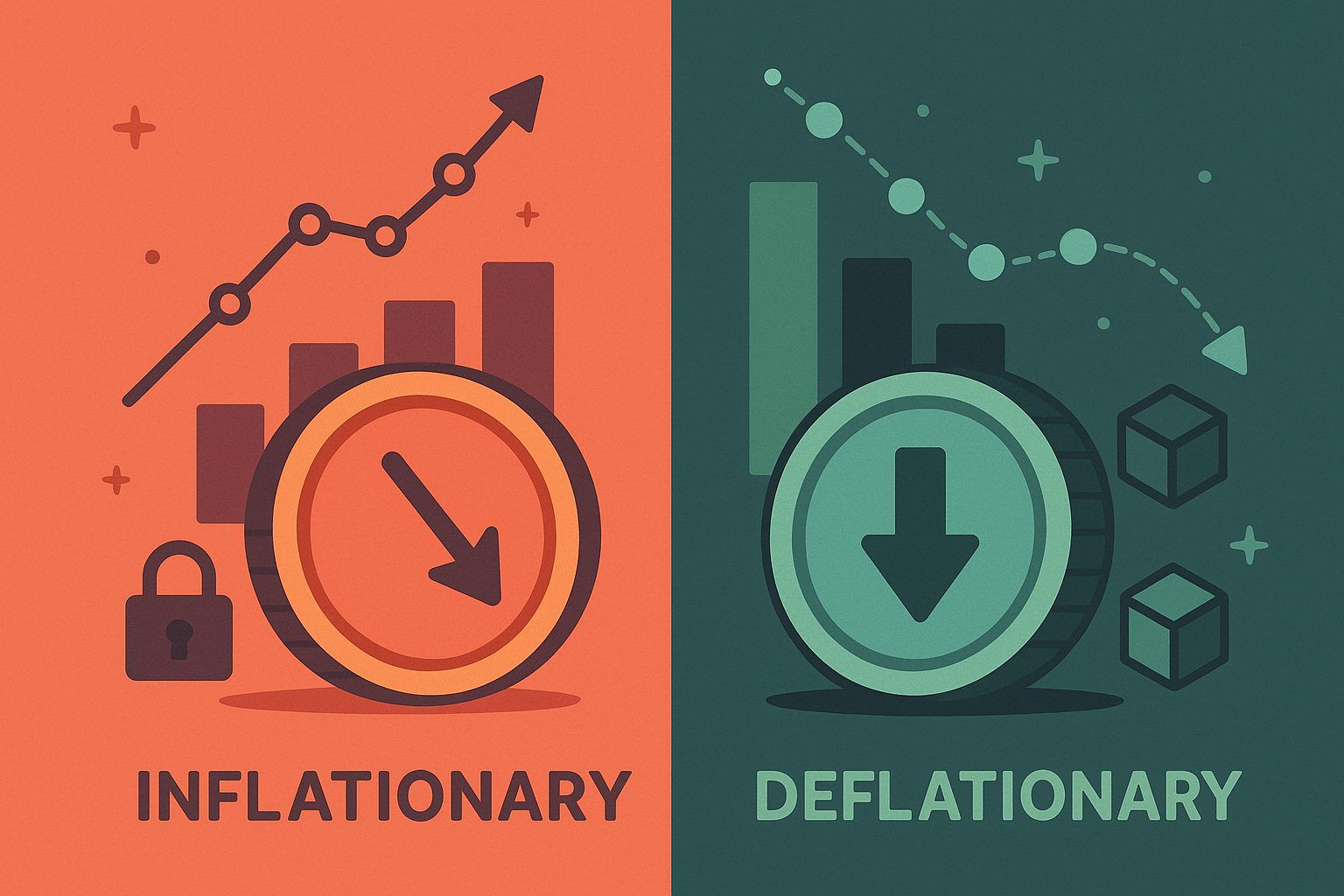Why Tokenomic Choices Define Your Project’s Trajectory
Every blockchain venture stands at a crossroads when it comes to token design. Beyond logos, roadmaps, and marketing hype, the supply mechanism you choose can dictate your project’s momentum, community sentiment, and long‐term viability. Inflationary and deflationary models each offer unique levers to influence behavior, align incentives, and shape market dynamics. Yet, these twin paradigms are not one‐size‐fits‐all solutions. Understanding their nuanced trade‐offs is critical for founders who aim to build enduring ecosystems, whether launching a decentralized finance protocol, a community governance token, or a utility asset for a new platform.
In this guide, we delve into the core mechanics of inflationary versus deflationary token models, explore hybrid approaches that blend both philosophies, and equip you with a structured framework to evaluate which design aligns best with your project’s goals. Through real‐world examples, economic insights, and practical roadmaps, you’ll discover how to calibrate supply strategies that foster growth without sacrificing value, community trust without stifling participation, and stability without sacrificing innovation.
When More Is More: Exploring Inflationary Token Models
Inflationary token economies expand supply over time, deliberately minting new units to reward participants, fuel network effects, or subsidize platform services. This design mirrors traditional fiat systems where central banks issue additional currency to incentivize spending and stimulate economic activity. In the crypto realm, newly minted tokens are often allocated to miners or validators securing the network, developers contributing code, and early adopters who take on elevated project risks. By providing a predictable issuance schedule—sometimes with halving events or annual percentage rates—projects can signal transparency and plan for consistent reward distributions.
However, unchecked inflation risks diluting value. If token issuance outpaces demand growth, prices may stagnate or decline, eroding holder confidence. To mitigate this, many inflationary models incorporate decay functions that taper rewards as network adoption matures. Others tie inflation rates to on‐chain metrics such as transaction volume or total value locked, ensuring that supply growth corresponds to real usage. By dynamically adjusting issuance in proportion to ecosystem activity, growth‐oriented protocols can strike a balance between rewarding early contributions and preserving future token value.
The Power of Less: Unpacking Deflationary Token Economies
Deflationary token models pull in the opposite direction, systematically reducing circulating supply to elevate scarcity and drive value appreciation. At its simplest, deflation occurs through token burns—permanent destruction of units via irrecoverable addresses. These burns can be triggered by transaction fees, protocol revenues, or dedicated buyback mechanisms funded by platform earnings. As supply contracts, each remaining token theoretically commands a larger share of the total value, incentivizing holders to accumulate and retain rather than trade or spend.
Beyond symbolic scarcity, deflationary mechanics can align community interests with project success. If a portion of network fees is burned when users transact, high platform adoption directly accelerates deflation, rewarding backers for driving usage. Yet, deflation brings its own challenges: overly aggressive supply contraction can impair liquidity and deter newcomers faced with steep token prices. Calibrating burn rates in tandem with reserve unlock schedules and liquidity provisioning measures is paramount to avoid volatility spikes that undermine user trust.
Growth vs. Value Preservation: Striking the Elusive Balance
At its core, the inflationary-deflationary debate boils down to competing objectives. Inflationary schemes prioritize network growth, rewarding activity and lowering entry barriers for new participants. In contrast, deflationary models emphasize value preservation, appealing to long-term holders and value investors. The ideal tokenomic design depends on your project’s maturity stage, use case, and user profile.
Early‐stage protocols often lean on inflationary issuance to galvanize network effects, incentivize node operators, and seed liquidity pools. As adoption solidifies, they may transition toward deflationary hooks—burning a fraction of fees or introducing buyback events—to sustain value momentum. This staged approach allows projects to harness the benefits of both paradigms: rapid growth through generous rewards, followed by scarcity‐driven value enhancement as the ecosystem matures.
Incentivizing Participation vs. Cultivating Scarcity
Within inflationary frameworks, token rewards serve as the lifeblood of community engagement. Validators receive mint allocators for securing consensus, content creators earn tokens for contributions, and referral programs distribute newly minted units to expand user bases. These rewards catalyze platform activity but demand vigilant monitoring: if token supply balloons faster than demand, inflation can outstrip utility, leading to disillusionment among backers who see their holdings diluted.
Deflationary models flip the script, using the promise of increasing scarcity to foster long-term loyalty. A common tactic is transaction-linked burns, where every swap or transfer consumes a small token fraction. This design not only deters frivolous trading but positions token use as a direct driver of value appreciation. Yet, scarcity alone cannot underwrite ecosystem vibrancy. Projects must complement deflationary mechanics with robust utility—staking, governance rights, or platform discounts—to ensure that token demand remains healthy even as supply contracts.
Bridging Dualities: Crafting Hybrid Supply Architectures
Neither inflation nor deflation holds a monopoly on best practices. Hybrid tokenomic models weave together complementary elements: tokens are minted to reward early users and bootstrap liquidity, then gradually transitioned into deflationary modes through scheduled burns or revenue buybacks. This layered approach enables nuanced control over supply dynamics, offering growth incentives when needed and scarcity triggers to shore up value.
Consider a gaming protocol that issues tokens to players and validators in its inaugural year, then shifts to a revenue-backed burn of marketplace transaction fees thereafter. Such a design kickstarts community formation while ensuring that tokenomics evolve with project milestones. Hybrid models require clear communication and transparent smart contract logic to avoid stakeholder confusion. By publicly sharing issuance schedules, burn algorithms, and reserve policies, founders can build trust and guide expectations through each phase of token lifecycle.
Governance’s Role in Supply Decisions
Token supply decisions rarely exist in a vacuum. Governance frameworks empower stakeholders—holders, developers, and node operators—to propose and vote on parameter changes, including inflation rates, burning mechanisms, and reserve allocations. Embedding supply levers within decentralized governance not only decentralizes authority but imbues tokenomic adjustments with social legitimacy, reducing the risk of unilateral protocol modifications.
Effective governance design often pairs vesting schedules with voting rights to align incentives over time. Founders and advisors may receive token allocations on multi-year vesting to discourage rapid sell-offs, while voting power scales with stake and contribution. Some projects embrace quadratic voting to guard against whale dominance, ensuring that supply decisions reflect the nuanced preferences of a diverse community. By linking token supply control to broad stakeholder consensus, projects foster a resilient economy that can adapt to market shifts without fracturing foundational trust.
Safeguarding Market Health: Liquidity and Stability Imperatives
Supply mechanics intersect deeply with market stability. In highly deflationary ecosystems, dwindling circulating tokens can thin order books, widen spreads, and amplify price volatility. Conversely, runaway inflation may flood markets, undermining token value and scaring away institutional participants. Strategic liquidity management is thus indispensable: protocols should allocate a portion of tokens to liquidity pools, maintain reserve cushions for buybacks, and institute vesting schedules that prevent large tranche dumps.
Automated market makers (AMMs) can be configured to divert a percentage of swap fees into liquidity reserves rather than burns, preserving depth while still enabling deflationary pressure. Alternatively, buy-and-burn schemes funded by protocol revenues can shore up floor prices during bear markets. Continuous analytics—tracking metrics such as bid-ask spreads, token velocity, and reserve-to-circulation ratios—enable proactive adjustments. By marrying supply mechanics with liquidity safeguards, founders can cultivate markets that are both vibrant and resilient, supporting organic growth without sacrificing trader confidence.
Aligning Economics with Community Psychology
Tokenomics thrives at the intersection of economics and human behavior. Beyond raw supply figures, the narratives you craft around inflation or deflation influence perception and adoption. Early adopters may revel in inflationary rewards, viewing them as a chance to participate in a burgeoning movement. Value investors, however, may gravitate toward deflationary promises, seeking the security of scarcity‐driven upside.
Successful projects articulate clear stories: inflationary issuance fuels network growth and decentralization, while periodic burns commemorate milestones and celebrate customer adoption. Community education—via detailed tokenomics whitepapers, interactive dashboards, and AMA sessions—demystifies the underlying mechanics, empowering holders to make informed decisions. By weaving behavioral insights into supply strategies, teams can foster both excitement and confidence, aligning token price trajectories with the rhythms of human anticipation and reward.
Modeling for Predictable Outcomes: Data-Driven Supply Simulations
Speculative markets are rife with uncertainty, yet token supply design need not be a leap in the dark. Advanced economic modeling tools allow founders to simulate issuance and burn scenarios under varied conditions: bull runs, prolonged bear phases, or sudden demand surges. By feeding historical on‐chain data—transaction volumes, active addresses, and revenue figures—into predictive models, teams can stress‐test tokenomic parameters and identify potential pitfalls.
Scenario analysis reveals tipping points where inflation may outpace demand or deflation might erode liquidity. Armed with these insights, founders can incorporate adaptive triggers—such as burn rate throttles that pause deflation if circulating supply falls below a threshold. Continuous monitoring, coupled with governance buffers for manual overrides, ensures that tokenomics remain responsive to real‐time developments. In an ever‐evolving crypto landscape, data‐driven design transforms token supply from a theoretical blueprint into a living, adaptive framework.
Tales from the Trenches: Inflationary Model Successes
Consider NetworkX, a decentralized lending protocol that launched with a 10% annual inflation rate to reward liquidity providers and attract institutional partners. Within six months, total value locked surged tenfold, liquidity pools deepened, and active user counts tripled. As adoption stabilized, NetworkX implemented a governance‐approved proposal to taper inflation to 2% annually, channeling excess fees into a burn reserve. This staged approach harnessed early growth while transitioning smoothly into value preservation, earning praise from both retail users and venture investors.
Another exemplar is GovToken, a DAO‐focused token that uses inflationary issuance to allocate voting power to active contributors. Monthly “engagement airdrops” reward proposal authors, forum moderators, and code reviewers, ensuring that governance participation remains robust. By tying token distribution directly to on‐chain and off-chain contributions, GovToken keeps its inflation rate in check while incentivizing meaningful work, demonstrating that inflation can be a potent tool for decentralization and community empowerment.
Tales from the Trenches: Deflationary Model Wins
On the deflationary front, SwapBurn has become a hallmark case study. As a decentralized exchange, it routes 0.05% of every trade into a burn contract. Over two years, the team burned over 15% of the initial supply, driving consistent token appreciation while maintaining tight liquidity through dedicated AMM pools. Users flocked to the platform, attracted by the dual benefits of low trading fees and the promise of perpetual scarcity. SwapBurn’s transparent burn dashboard and monthly “Burn Day” events turned supply contraction into a community spectacle, reinforcing token holder loyalty.
Similarly, StakeSlash—an innovative proof‐of‐stake network—penalizes misbehaving validators by slashing their stakes and burning the confiscated tokens. This punitive deflation not only secures network integrity but also enhances scarcity over time. The combination of robust security incentives and a transparent slashing‐burn mechanism has attracted cautious institutional stakers who value both protocol safety and long‐term tokenomics health.
Navigating Common Pitfalls: What to Avoid
Even the most well‐intentioned token designs can stumble. Projects that front‐load excessive inflation risk disenfranchising early supporters when issuance outpaces perceived value. Conversely, deflationary tokens with unchecked burn rates may hollow out liquidity, resulting in erratic price swings that alienate new entrants. Opaque reserve policies—where team allocations unlock suddenly—can erode trust if holders fear unforeseen token dumps.
To sidestep these hazards, prioritize transparency. Publish detailed vesting and burn schedules, audit smart contracts, and maintain live dashboards tracking supply metrics. Engage in open governance debates before implementing major supply changes, and consider fail‐safe mechanisms such as burn rate caps or pause functions in smart contracts. By anticipating edge cases and building in checks and balances, you’ll safeguard your ecosystem against volatility and community backlash.
Crafting Your Tokenomic Roadmap: A Step-by-Step Framework
Embarking on token supply design requires a methodical approach. Start by defining core objectives: are you seeking rapid network growth, value preservation for long‐term holders, or a blend of both? Next, map out initial supply parameters: total cap, allocation splits, and issuance schedules. Simulate different market scenarios using on‐chain analytics, then refine your model to address liquidity thresholds, burn triggers, and governance interfaces. Incorporate vesting arrangements for team and advisor tokens that align with project milestones, and allocate reserves for future development, partnerships, and community incentives.
Once the blueprint is finalized, deploy smart contracts on testnets for rigorous auditing and community feedback. Host AMA sessions to educate stakeholders and field concerns, then roll out a phased mainnet launch with clear communication of each supply phase. Post‐launch, maintain transparency through dashboards, regular burn reports, and governance proposals for parameter adjustments. By following a disciplined, data‐driven roadmap that emphasizes stakeholder engagement, you can navigate the complexities of both inflationary and deflationary models with confidence.
Charting Tomorrow’s Supply Innovations
As blockchain ecosystems evolve, tokenomic experimentation will continue to accelerate. Programmable bonding curves, cross‐chain deflationary hooks, and AI-driven issuance algorithms promise new frontiers for supply management. Meanwhile, regulatory landscapes may necessitate hybrid compliance models that embed geofencing or identity verification into token mechanics. Projects integrating environmental, social, and governance (ESG) criteria—such as burning tokens in tandem with carbon offset purchases—will further expand the supply design palette.
In this dynamic environment, the ultimate winners will be those who treat token supply as a living framework, not a static contract. By combining rigorous economic analysis, transparent governance, and adaptive smart contract logic, founders can craft supply strategies that resonate with both market demands and community values. The interplay between inflation and deflation will remain a critical lever in shaping the next generation of decentralized networks, powering sustainable growth and enduring value creation.
Final Thoughts: Aligning Tokenomics with Your Vision
The choice between inflationary, deflationary, or hybrid token models is more than a technical detail—it is a strategic manifesto that reflects your project’s ethos, stage of maturity, and community priorities. Inflationary designs can accelerate network effects and democratize participation, while deflationary mechanisms cultivate scarcity and value retention. Hybrid architectures unlock the best of both worlds, provided they are underpinned by transparent governance and robust analytics.
As you embark on this journey, remember that tokenomics is both art and science. Ground your decisions in empirical data, stress‐test scenarios for edge cases, and engage your community in open governance debates. With a thoughtfully designed supply mechanism, you can build a resilient token economy that not only survives but thrives—driving innovation, empowering stakeholders, and laying the foundation for long‐term success in the rapidly evolving world of decentralized finance and beyond.




